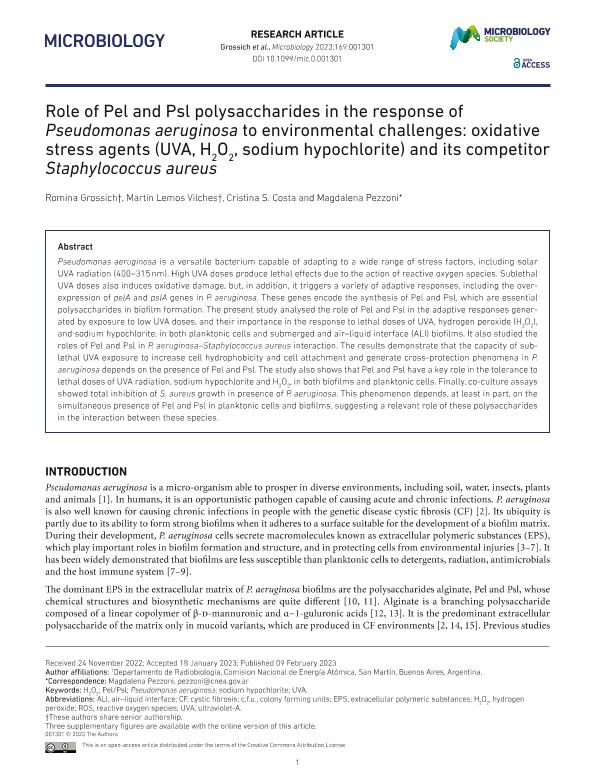Mostrar el registro sencillo del ítem
dc.contributor.author
Grossich, Romina
dc.contributor.author
Lemos Vilches, Martín Oscar

dc.contributor.author
Costa, Cristina Susana

dc.contributor.author
Pezzoni, Magdalena

dc.date.available
2024-01-30T11:41:01Z
dc.date.issued
2023-02
dc.identifier.citation
Grossich, Romina; Lemos Vilches, Martín Oscar; Costa, Cristina Susana; Pezzoni, Magdalena; Role of Pel and Psl polysaccharides in the response of Pseudomonas aeruginosa to environmental challenges: Oxidative stress agents (UVA, H2 O2, sodium hypochlorite) and its competitor Staphylococcus aureus; Society for General Microbiology; Microbiology-UK; 169; 2; 2-2023; 1-16
dc.identifier.issn
1350-0872
dc.identifier.uri
http://hdl.handle.net/11336/225158
dc.description.abstract
Pseudomonas aeruginosa is a versatile bacterium capable of adapting to a wide range of stress factors, including solar UVA radiation (400–315 nm). High UVA doses produce lethal effects due to the action of reactive oxygen species. Sublethal UVA doses also induces oxidative damage, but, in addition, it triggers a variety of adaptive responses, including the over-expression of pelA and pslA genes in P. aeruginosa. These genes encode the synthesis of Pel and Psl, which are essential polysaccharides in biofilm formation. The present study analysed the role of Pel and Psl in the adaptive responses gener-ated by exposure to low UVA doses, and their importance in the response to lethal doses of UVA, hydrogen peroxide (H2 O2), and sodium hypochlorite, in both planktonic cells and submerged and air–liquid interface (ALI) biofilms. It also studied the roles of Pel and Psl in P. aeruginosa–Staphylococcus aureus interaction. The results demonstrate that the capacity of sub-lethal UVA exposure to increase cell hydrophobicity and cell attachment and generate cross-protection phenomena in P. aeruginosa depends on the presence of Pel and Psl. The study also shows that Pel and Psl have a key role in the tolerance to lethal doses of UVA radiation, sodium hypochlorite and H2 O2, in both biofilms and planktonic cells. Finally, co-culture assays showed total inhibition of S. aureus growth in presence of P. aeruginosa. This phenomenon depends, at least in part, on the simultaneous presence of Pel and Psl in planktonic cells and biofilms, suggesting a relevant role of these polysaccharides in the interaction between these species.
dc.format
application/pdf
dc.language.iso
eng
dc.publisher
Society for General Microbiology

dc.rights
info:eu-repo/semantics/openAccess
dc.rights.uri
https://creativecommons.org/licenses/by/2.5/ar/
dc.subject
H2 O2
dc.subject
PEL/PSL
dc.subject
PSEUDOMONAS AERUGINOSA
dc.subject
SODIUM HYPOCHLORITE
dc.subject
UVA
dc.subject.classification
Biología Celular, Microbiología

dc.subject.classification
Ciencias Biológicas

dc.subject.classification
CIENCIAS NATURALES Y EXACTAS

dc.title
Role of Pel and Psl polysaccharides in the response of Pseudomonas aeruginosa to environmental challenges: Oxidative stress agents (UVA, H2 O2, sodium hypochlorite) and its competitor Staphylococcus aureus
dc.type
info:eu-repo/semantics/article
dc.type
info:ar-repo/semantics/artículo
dc.type
info:eu-repo/semantics/publishedVersion
dc.date.updated
2024-01-29T13:06:28Z
dc.journal.volume
169
dc.journal.number
2
dc.journal.pagination
1-16
dc.journal.pais
Reino Unido

dc.journal.ciudad
Londres
dc.description.fil
Fil: Grossich, Romina. Comisión Nacional de Energía Atómica. Gerencia de Área de Aplicaciones de la Tecnología Nuclear. Departamento de Radiobiología; Argentina
dc.description.fil
Fil: Lemos Vilches, Martín Oscar. Comisión Nacional de Energía Atómica. Gerencia de Área de Aplicaciones de la Tecnología Nuclear. Departamento de Radiobiología; Argentina
dc.description.fil
Fil: Costa, Cristina Susana. Comisión Nacional de Energía Atómica. Gerencia de Área de Aplicaciones de la Tecnología Nuclear. Departamento de Radiobiología; Argentina
dc.description.fil
Fil: Pezzoni, Magdalena. Consejo Nacional de Investigaciones Científicas y Técnicas; Argentina. Comisión Nacional de Energía Atómica. Gerencia de Área de Aplicaciones de la Tecnología Nuclear. Departamento de Radiobiología; Argentina. Ministerio de Educación, Cultura, Ciencia y Tecnología. Consejo Interuniversitario Nacional; Argentina
dc.journal.title
Microbiology-UK

dc.relation.alternativeid
info:eu-repo/semantics/altIdentifier/url/https://www.microbiologyresearch.org/content/journal/micro/10.1099/mic.0.001301
dc.relation.alternativeid
info:eu-repo/semantics/altIdentifier/doi/http://dx.doi.org/10.1099/mic.0.001301
Archivos asociados
